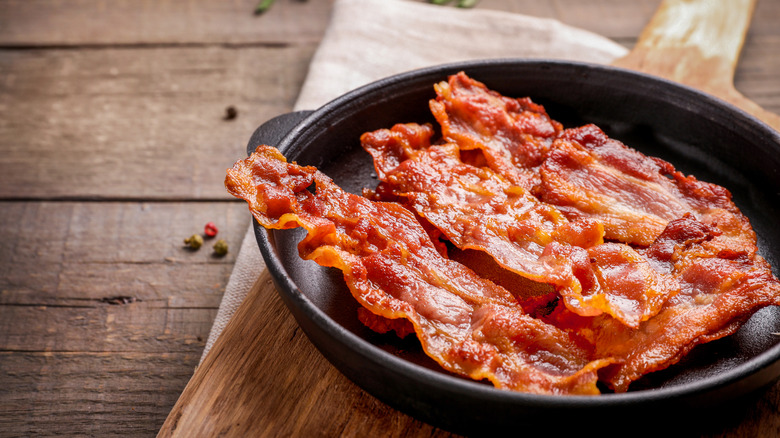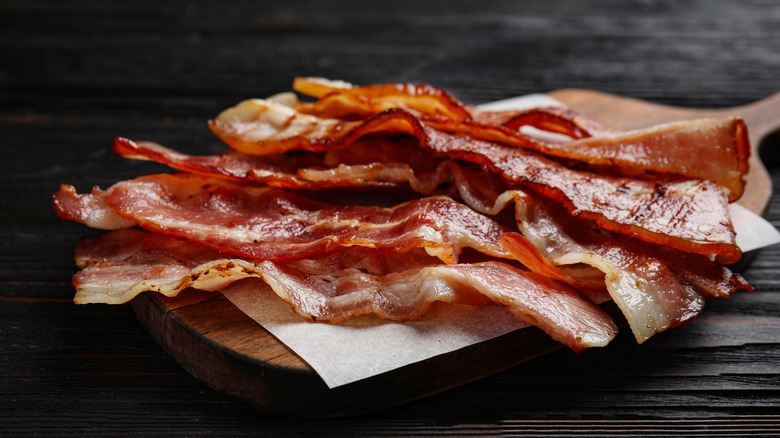Avoid Cooking Bacon On A Cooling Rack At All Costs. Here's Exactly Why
Bacon: Whether it's for breakfast, on a sandwich, or just served by itself on a plate, it's a welcome addition to any occasion. Have some potato soup? Add some bacon and cheese to that bad boy. Serving up some pancakes one Saturday morning? Nothing beats maple syrup and bacon, right? While bacon is a versatile ingredient able to be included in many dishes, it can also be prepared in a wide variety of ways, each with its own benefits.
You may be a fan of cooking bacon directly in a pan just like your parents did, tossing strips of raw bacon into a ripping-hot skillet and frying until golden brown and crispy. If you're not a fan of the grease that inevitably comes from cooking bacon in a skillet, you may be a fan of making bacon in the microwave —a process that, while taking a bit longer than the skillet method, provides crispy bacon without it being soaked in grease. You can even cook your bacon in an air fryer, should you be willing to see if "air-fried bacon" is something you may enjoy.
While all of these methods are no doubt very good ways to prepare bacon without much trouble, there is one method that you should try to avoid: using a cooling rack. What exactly is it about this method that you should avoid? Is it because it's dangerous? Is it unhealthy? Or is it just a really bad way of cooking your bacon, to begin with?
Cooking bacon on a cooling rack gives a meatier texture
Now, to cook bacon on a cooling rack obviously means you have to cook the bacon in the oven. Truth be told, there's really nothing wrong with cooking your bacon in the oven. It's not only easy, but it cooks the bacon much more evenly than you would on the stovetop. But why should you avoid using a cooling rack?
When you use a cooling rack rather than a baking sheet, the bacon will not come out crispy and firm as you'd expect it to be, but will instead have a "meatier" texture. Rather than crisping up, the bacon gets chewy, like warming up raw meat. This is because the heat doesn't move through the bacon properly and can cook one side of the bacon while the other side simply boils in its own grease.
If you must use a cooling rack to cook bacon, however, cover the rack with tin foil and then place the rack on a baking sheet, instead of laying the bacon right across the bare metal of the rack. Take the bacon out of the oven every few minutes and flip it to ensure that the bacon is getting cooked evenly on all sides. While it may not be as crisp as the microwave or air fryer, you can still serve this bacon as you normally would, or chop it up and serve it in a dish of your choosing.
Is there a better way to cook bacon?
If preparing your bacon on a cooling rack leads to meatier, chewier bacon and a build-up of scalding grease, is there a better, safer way to prepare your bacon? And, is there a method of cooking bacon in the oven that avoids the use of any type of rack altogether?
Nashia Baker of Martha Stewart discovered that parchment paper is actually a very good substitute for cooking bacon on a cooling rack. This method simply has you line a baking sheet with parchment paper, lay the strips of bacon flat across the surface, and then cook in the oven at 400 degrees Fahrenheit for 15 to 18 minutes, rotating in between. What makes this method much better than the cooling rack method is twofold: The bacon lies flat across the surface, exposing all sides of it to the heat; and, unlike the rack method, there's very little "spatter," or build-up of grease that could bubble and burst inside your oven.
While you will still have bacon grease, it will be much easier to drain off than you would have to do with a cooling rack. You also avoid the process of taking the bacon out of the oven and flipping it, further preventing you from coming into constant contact with the hot grease.


